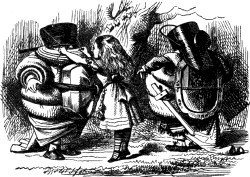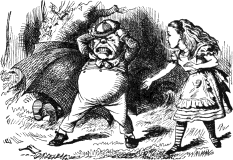

A paradox bid is a non-forcing call of the suit you don't hold when length in one of two suits has been shown or implied by partner's bid, generally when the partnership expects to subside in one of these suits. Let's start with an example, bid against me by an efficient looking Italian pair at the 1998 European Mixed in Aachen.
In this writeup suit-ambiguous bids are marked "¥" and ParadoX advances "¶"
| A deal from play: Advancing an ambiguous major overcall | |||||||||||||||||||||||||||||||
Strange auction against unknown opponents! I assume this was part of a
more general defence to phoney club. East's response of
1 I was North and actually held clubs with 4 spades for my 1
Look what has happened. Opponennts have got in first and now it's you who has to guess. Furthermore, using relays there is no room for you to play in hearts at the one level (unless you agree that you might pass the relay). Paradox advances always save one step, and always allow you to drop the auction at the existing level. Do you get the idea? Here West has shown an undisclosed major. If East can raise one, she bids the other one. Therein lies the paradox! You have overcalled ambiguously at the one level but can still subside safely in
one of either major. You have messed up the phoney club, but opponents still don't
know your actual suit. You can use the now spare 1 As it happened my own partnership was already playing ParadoX in several situations ... |
Extending a strong 2 clubs | |
|
|
ParadoX negative responses allow you to incorporate 8 trick major Acol Twos into
otherwise game forcing 2
The challenge is to open 2
In the examples partner has opened 2  J32 J32  853 853
 10852 10852  Q84 Q84 Nothing for either major. Bid 2  Q5 Q5  93 93
 10763 10763  J9652 J9652Trick for spades only - bid 2  3 3  J853 J853
 J9643 J9643  862 862 Your 2  Q3 Q3  9853 9853
 85 85  J7532 J7532With a trick for either major you bid 2 The gains from this seemingly devious style:
You will need some ageements to force game or make
a slam tries. The full 2
2
 - 2 - 2 ¶; ¶;
pass!
2
 - 2 - 2 ¶ ¶
pass! Much to our opponent's surprise! |
ParadoX Tricks opposite the Multi 2 diamonds | |||||
|
|
I claim no originality for ParadoX advances which are an intrinsic part of the Multi.
But even here partnerships tend to underuse the method. Let's start with
"standard" responses
Partner opens Multi 2 ¥ showing a weak
two in either major (commonly) or various stong hands (rarely) ¥ showing a weak
two in either major (commonly) or various stong hands (rarely)
However ParadoX allows similar bids at the three level - extending the preempt
It would be nice to play similar ParadoX preempt extentions at the four level, but
my view and experience is that this does not work. There will always be hands where
you simply want to simply bid game in your own major when partner pre-empts.
4 |
ParadoX and lebensohl | |||||
|
|
The basic lebensohl situation is that one player has shown values via perhaps a no-trump bid or double and an opponent
has made a bid at the 2 level. The lebensohl bid is then 2NT* commanding a 3 "puppet" reply
which is either passed or converted to another suit "to play". Direct bids of a
suit can then be played as forcing. Lebensohl and ParadoX advances are just made for each other .. "puppet" reply
which is either passed or converted to another suit "to play". Direct bids of a
suit can then be played as forcing. Lebensohl and ParadoX advances are just made for each other ..
Pairs nv/nv - 1NT is weak or mini
Partner has commanded a 3 Tell him about that with a ParadoX 3 Note that it is safe to force the 4 level should there be 9-10 card club fit. The LAW will protect you non vulnerable. 
 was Dutch style showing
5/4 hearts with minor side suit. Again you safely indicate clubs by bidding
diamonds¶. Often this may not matter, but can prepare the ground
for spectacular action should partner hold say was Dutch style showing
5/4 hearts with minor side suit. Again you safely indicate clubs by bidding
diamonds¶. Often this may not matter, but can prepare the ground
for spectacular action should partner hold say
 Q983 Q983
 6 6
 10 10
 10987542 10987542
A good example of what Paradox in competition is about. The call may make no difference to you, but facilitates your partner's bidding considerably. |
ParadoX opposite 1NT defences | |||
|
|
Pairs nv/vul: Your left hand opponent open 1NT
The "DONT" 1NT double and Cappitelli 2 "Long unspecified suit" you say! Of course ParadoX advances are on here. I'd call a cheeky 2 |
Using a Multi bid after partner opens | |
|
|
While the Multi 2 evolved as preempt, there is no reason why you cannot
apply the same principles show a weak long suit once partner has opened! This works best opposite
shortish minors that may commonly be a balanced hand outside your 1NT range. Multi's 'built in'
ParadoX advances make this audacious gambit quite safe. evolved as preempt, there is no reason why you cannot
apply the same principles show a weak long suit once partner has opened! This works best opposite
shortish minors that may commonly be a balanced hand outside your 1NT range. Multi's 'built in'
ParadoX advances make this audacious gambit quite safe.
My thanks to Belgium's Tom Huybrechts for sending these innovative extensions to me. He uses this
style to allow weak jump shifts and fit jumps opposite a loose 1 |
Putting more into semi constructive sequences | ||||
I like to play a mini no trump, and with a six card suit opposite we will pre-empt to the three level
guaranteed an 8-9 card fit. 1NT - 3 ! - all pass on a combined 17 points scores just fine. ! - all pass on a combined 17 points scores just fine.
Playing all four 3 level suit bids as preempts does however put a lot of strain on your conventional two level
sequences. This page isn't about 1NT bidding, but once again I like an ambiguous bid - 2 Both of the hands below hands pose a problem opposite partner's 9-12 mini no trump.
The first may scramble a thin game, but will be in trouble if the diamonds cannot be
run. You need an honour. The old Blue Club approach of 3 of a minor inviting 3NT
solved this, but with ParadoX you can handle both of these via a 2
Knowing the long suit will be fluid the first hand can bid a cheeky 3NT. Opponents still don't know
our long suit! The perfect reply for the second hand is interestingly 3 As in the other examples you still subside in 3 of a minor if the suit is not running. Over 2NT positive for both minors responder bids 3NT with the first hand and shows his suit forcing/slammish with the second inviting a cue. The general method is perfectly playable opposite stonger no trump ranges, but you may have strong 3 level bids available and not need it. |
Other applications | |
|
|
If you make bids where one or more of your suits is always there but undefined then you will have
opportunities for ParadoX advances. Some that I have used or come across:
|

![]() Links to my own bridge homepage,
Links to my own bridge homepage,
and the chrisryall.net Weak Two Archive. If you find ParadoX
advances interesting you can link here from your own Bridge site
|
|
www.chrisryall.net/bridge/paradox.htm © Chris Ryall 1987-2008
|